Retention Marketing: Your Key to Lower Customer Acquisition Cost in 2024
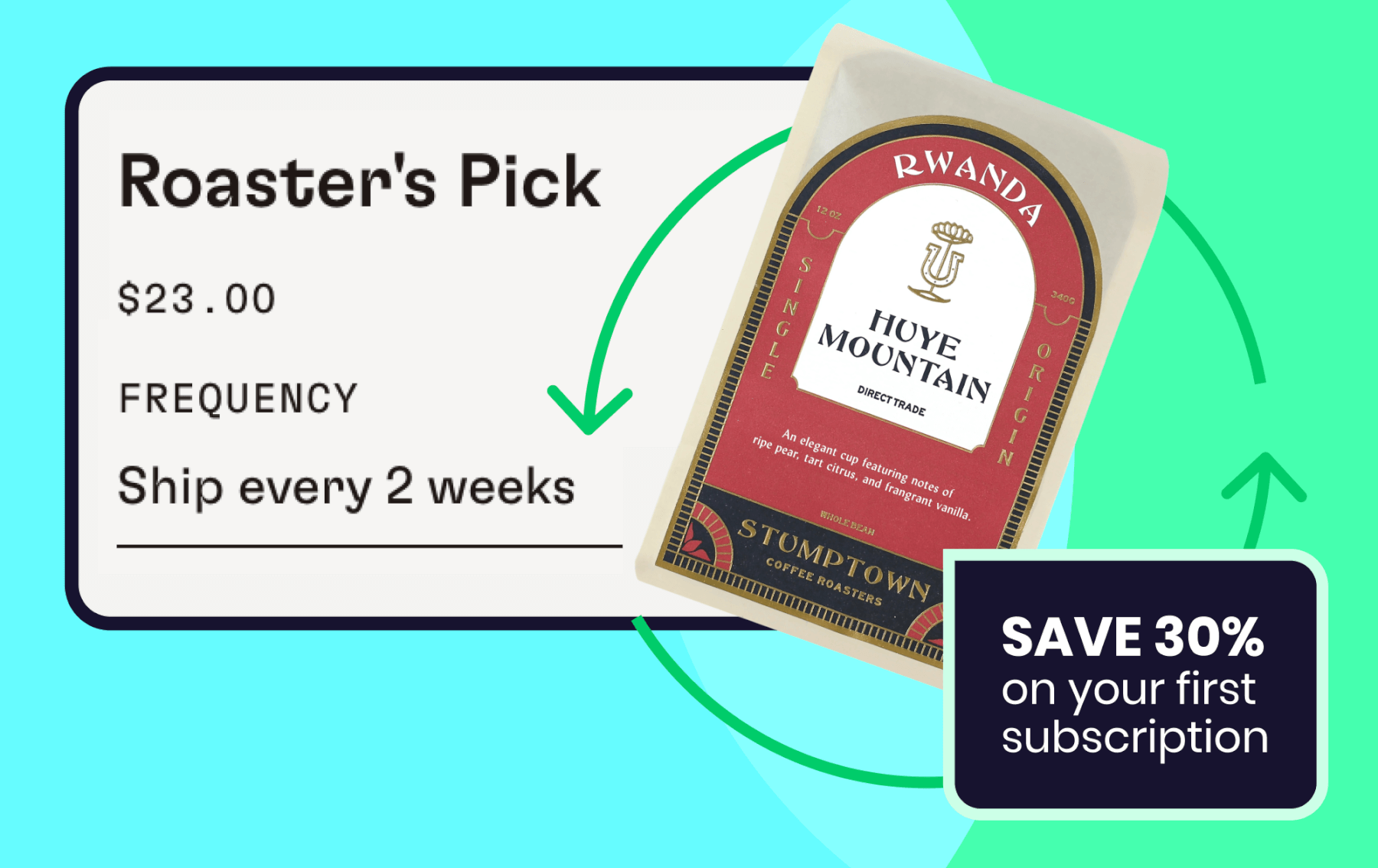
Spending too much on customer acquisition? In this economy?
You’re not alone — but it may not be the best use of budget. According to Salesforce, the odds of turning a first-time browser into a buyer are just 5-20%, while the likelihood of turning an existing customer into a repeat buyer is 60-70%.
Those repeat buyers are worth their weight in gold. Depending on the study, they spend up to 67% more per purchase and account for 50% or more of total sales.
And because it’s easier (and 6 to 7 times cheaper) to sell to an audience you already have a relationship with, a loyal customer base might be just what you need to quickly move the needle on marketing ROI. After all, it only takes a 5% lift in customer retention to increase company revenue by 25-95%.
With consumers tightening their purse strings — not to mention raising the bar on who they’ll do business with whatsoever — the brands that stand the test of the time will be the ones deploying a retention marketing strategy to offset the costs of customer acquisition, grow their customer lifetime value (CLV), and win more recurring revenue.
Here’s what you need to know about retention marketing to join their ranks and start making the most of your happy customers.
What is retention marketing?
Unlike acquisition marketing efforts intended to win over net new customers, retention marketing is all about engaging the customers you’ve already acquired to become their go-to choice in a given category.
In practice, retention marketing campaigns can take many forms — and brands are getting more and more creative in how they choose to nurture repeat buyers and re-engage inactive customers.
Loyalty programs, subscriptions, VIP, memberships, winback email campaigns and discount codes — and even customer accounts that store payment info — are all examples of retention marketing in action.
Why retention marketing is so important
Done right, retention marketing means more customer loyalty, which tends to bring with it more repeat purchases, lower marketing costs, and more profit.
Reason being that acquisition alone can only fuel growth for so long — according to the 80/20 rule, 20% of customers generate about 80% business. So, if acquisition marketing is like a leaky bucket, then retention marketing can be the plug that offsets acquisition costs to create a more sustainable engine for business growth.
Of course there’s a time and place for both marketing approaches. But if acquisition marketing isn’t paired with some retention efforts right off the bat, the new customers you win today might become former customers tomorrow.
And if they happen to become loyal to another brand? For all intents and purposes, they’re a new customer to acquire all over again.
How to measure retention marketing success
Customer data is the backbone of successful retention marketing. Without it marketers have little insight into how customers are already engaging with the brand, why they might be churning, and what they can do to stop it.
Top 5 customer retention metrics to track
Is it taking years for customers to purchase again? Are they purchasing again at all?
With no shortage of retention metrics out there to track, it’s up to brands to determine exactly where they want to improve, define what success means for them, benchmark the current state, and track their progress accordingly.
Below is a short list of the most important customer retention metrics to consider.
Customer retention rate
The rate at which a business retains customers over a period of time, calculated by:
Customer Retention Rate = (Customers at the end of the period) – (New customers acquired) / Customers at the start of the period
Customer churn
The rate at which customers stop doing business with you over the course of a year, calculated by:
Annual churn rate = (Number of customers at start of year – Number of customers at end of year) / Number of customers at start of year
Repeat purchase ratio (or loyal customer rate)
The rate at which customers make a repeat purchase, calculated by:
Repeat purchase ratio = Number of returning customers / Number of total customers
Time between purchases
The average time it takes customers to make another purchase from you, calculated by:
Time between purchases = Sum of individual purchase rates / Number of repeat customers
Customer lifetime value
The amount of revenue generated by a single customer, calculated by:
Customer lifetime value = Customer value * Average customer lifespan
where customer value = Average purchase value * Average number of purchases
4 retention marketing strategies to build customer loyalty
When it comes to customer retention, the variables at play look different for each brand.
There may not be a one-size-fits-all retention marketing strategy to turn first-time customers into brand advocates overnight — but there are plenty of approaches any eCommerce brand would benefit from trying.
When in doubt, remember that retention marketing is a long game that can only be won when you truly put customer needs first.
Elevate your brand with digital memberships
With more purchasing options than ever these days, aiming for customer satisfaction alone doesn’t guarantee retention.
To shoot for the stars, brands have to build emotional connections with customers. When they do, they’ll find that emotionally connected shoppers spend up to 306% more — and stay loyal longer — than the average satisfied customer. One effective strategy to build these connections is through digital memberships.
Digital memberships allow you to provide exclusive services or benefits through a subscription model, creating a group of hyper-loyal customers. By offering exclusive benefits, content, or experiences, you create a sense of belonging and value that goes beyond the transactional relationship. This exclusivity not only attracts new customers but also retains existing ones, fostering a loyal customer base that is invested in your brand.
Launch a tailored subscription experience
Subscriptions have quickly become a mainstay across eCommerce categories for good reason: They’re a win-win for customers looking for convenience and value and brands looking for more recurring revenue — and there are three main types of subscriptions brands can experiment with to find what resonates best with their audience.
Subscribe and save
Also known as replenishment subscriptions, this type of experience provides customers with recurring deliveries of a certain product at a discount.
Bundles
When brands take a bundles approach, customers receive a varied range of products in each subscription delivery.
Some brands let customers build their own subscription box, while others offer guided selling quizzes — or even analyze relevant data, like previous order history and inventory status — to inform which products the customer receives.
Memberships
Membership subscriptions give customers access to a brand’s products or services for a recurring fee. Whether the subscription gives members a VIP experience — or access to exclusive products or services — brands get a flexible and creative way to engage customers and drive more revenue.
If your customer base cares about convenience — and most do — you can count on any of these subscription experiences to deliver.
Personalize the shopping experience with customer data
Research shows that 67% of shoppers not only want personalized offers based on their spending habits, but 72% buy more than they originally planned when they get them.
If you already have customers, then you already have some of the zero- and first-party customer data you need to deliver the type of personalized shopping experiences that lead to happy customers and higher CLV.
Personalization is about more than pre-purchase marketing segmentation — it should be part of the entire online shopping experience. Whether you choose to offer personalization based on individual order history, or ask customers directly about their preferences and needs, you can delight them with targeted messaging in marketing campaigns, data-driven product recommendations and offers — and even optimize your onsite experience specifically for returning customers.
Meaningful personalization has the potential to make customers’ life easier, stretch their dollars further, and introduce them to other products they’re sure to love.
Remove unnecessary friction from the shopping experience
There are two sides to every coin. Retention marketing is meant to increase customer loyalty — but with each new tactic you try, you run the risk of adding unnecessary complexities that can lose customers along the way. The key is removing any and all friction from the shopping experience.
Let’s say you decided to launch subscriptions, and a subscriber eventually winds up with more of your products on hand than they need. If that subscriber finds it challenging to manage the subscription, pause and skip orders, or even swap in other products to try, they’ll be more likely to cancel altogether. That leaves you back at square one with customer retention.
On the other hand, if your subscription solution is smart enough to anticipate a possible overstock and automatically prompts the customer to skip their next order, you’re more likely to prevent a cancellation. And removing that type of friction from the shopping experience can reduce churn by as much as 17%.
At the end of the day, removing friction from the shopping experience is a retention tactic in its own right — and it’s the key to success with any retention marketing strategy you try.
Real-life examples of retention marketing in action
If you’re ready to learn from the best, look no further than some of the top brands getting retention marketing right.
Peet’s Coffee fosters emotional connections with retention rewards
With one of the largest subscriber bases in the market, Peet’s Coffee’s philosophy is that subscribers are their most valuable customers — so, they partnered with Ordergroove to implement retention rewards that would keep them happy and enrolled.
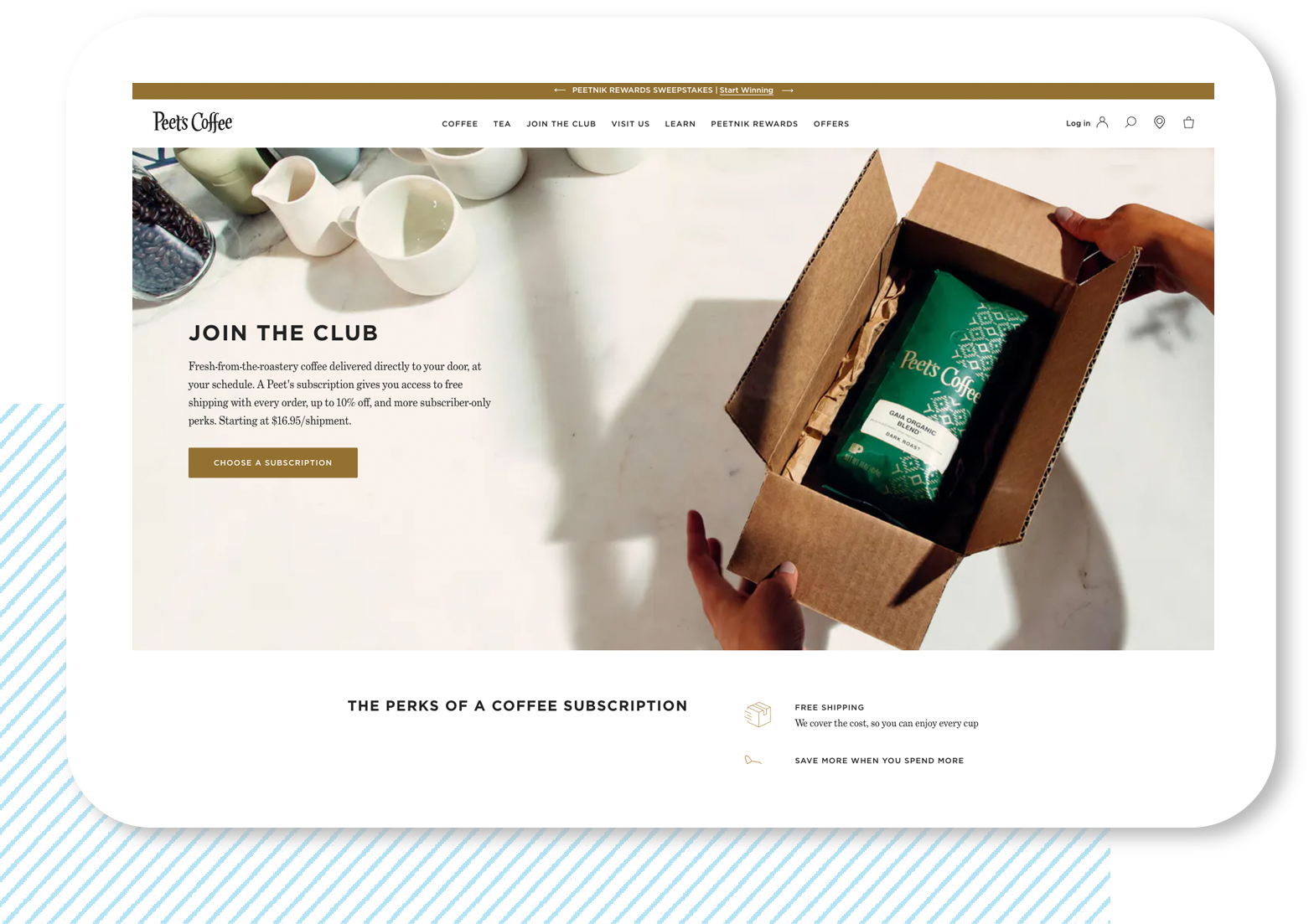
Once subscribers reached a certain order threshold, they’d receive a Peet’s Coffee pin as a free gift with purchase. Simple as it may sound, this token of appreciation was an effective way to build brand affinity by making subscribers feel like part of something bigger — like a member of a club, instead of just a customer.
Bonafide delivers personalized shopping experiences at scale
In a perfect world, personalized shopping experiences can work double duty to reduce friction onsite and drive bigger purchases. Just ask Bonafide, a health supplement brand using Ordergroove to engage existing customers with personalized upsell offers based on which products they already subscribe to.
It all comes down to their zero- and first-party data. Using customers’ Shopify IDs to create dynamic links for every email and SMS marketing communication, Bonafide ensures that customers are automatically logged into their subscription account when they arrive onsite.
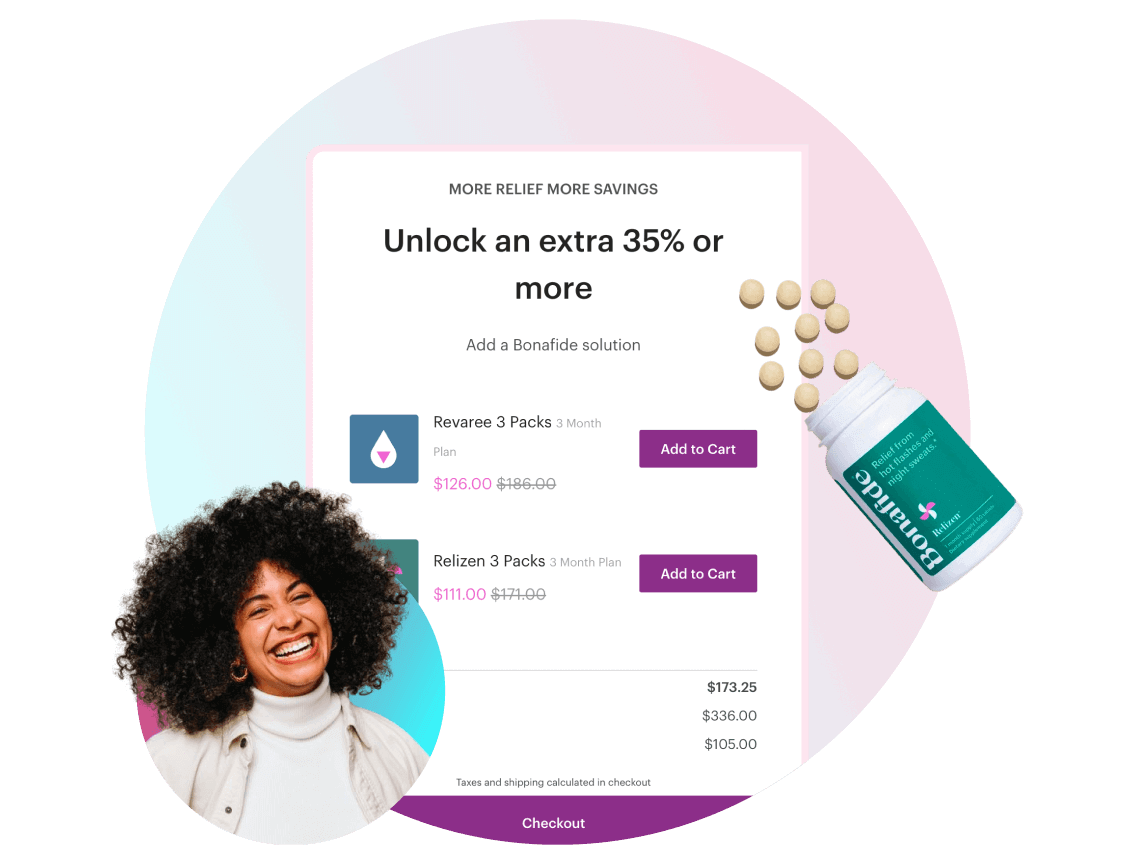
That way subscribers can add items to their subscription order in just one click no matter where they land on site. No checkout needed.
Good Ranchers puts value at the heart of their loyalty program
Good Ranchers would be the first to tell you that investing in customer loyalty is a great way to create valuable brand ambassadors. That’s exactly why they integrated Ordergroove with their loyalty program provider, making it easy for their most loyal customers to share their subscription experience with friends and family.
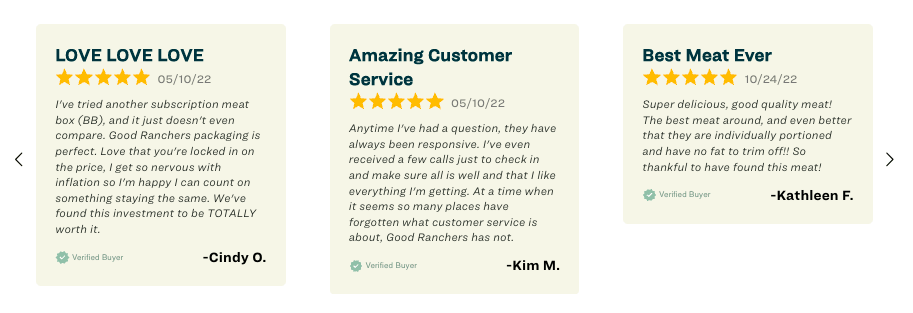
The program rewards one-time purchases, subscription purchases, and friends and family referrals with different ways for customers to earn points by engaging with their brand and unlock the kind of value that genuinely resonates with them.
“We try to build a lot of value into the loyalty program — we know that $2 off a $150 box isn’t going to swing people,” Gil says. “So we let customers quickly hit these point milestones and earn $25, $50, even $70 off their next box. We want them to feel that relationship forming and know that we’re willing to give them something back.”
Dollar Shave Club does away with friction
Dollar Shave Club has been pioneering subscriptions for over a decade. With millions of subscribers globally, a frictionless customer journey powered by a thoughtful tech stack is how they keep their most valuable customers coming back time after time.
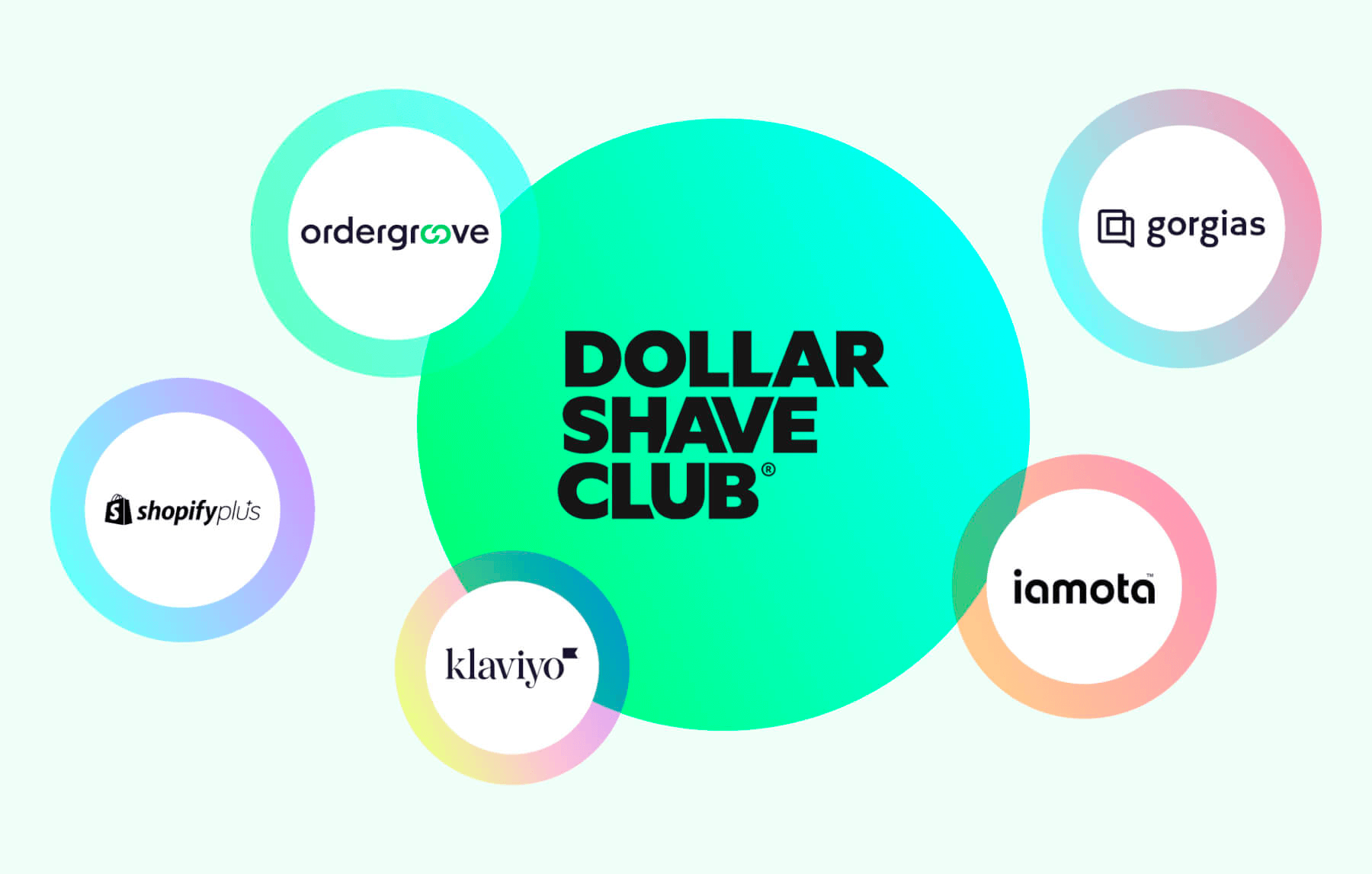
By focusing on optimizing the experience for new customers, existing subscribers, and internal teams alike, they’ve built a well-oiled retention marketing machine:
With Klaviyo handling their marketing automation, Dollar Shave Club can use data from their entire tech stack to craft tailor made email campaigns at scale.
With Gorgias streamlining their support channels into a seamless experience across live chat, social media, and email, agents have all the context they need to deliver a smooth experience.
Retention marketing FAQs
All of that said, you may still be wondering —
What factors have the biggest influence on customer loyalty and retention?
Customer loyalty is complex, and there are a number of factors that affect retention. Beyond obvious factors like convenience, price, and quality of products and services, building trust through transparency — and reciprocity — are a big part of customer loyalty and retention.
Retention marketing can be an opportunity to build trust by being honest about your products, services, and important policies — and strengthen it over time by showing you’re a brand that consistently does what it promises to do.
Overtime, that trust can turn into the kind of emotional connection that’s highly influential on customer loyalty and retention.
What are some best practices for retention marketing?
- Remember that retention marketing is a long game, so it can be challenging to meaningfully measure success in a short period of time. For an accurate analysis, look at time periods of at least 3 months — but a year’s worth of data is ideal.
- To confidently monitor the impact of your retention marketing tactics, ensure you have tracking and attribution set up for the metrics that matter most to your business.
- Embrace experimentation. With so many ways to engage customers, there’s no harm in trying out new marketing channels and tactics. Scale what works, and move on from what doesn’t.
What are the big retention marketing mistakes to avoid?
- Being careless with customer data and privacy. Data privacy is increasingly important to customers and it’s up to businesses to put a cap on it — and communicate about it.
- Hitting the wrong note with personalization. 39% of consumers have reported experiencing some creepy and invasive engagement tactics from well-intentioned brands.
- Ignoring customer feedback. Retention marketing strategies that don’t take direct customer feedback into account can turn out misguided at best, and tone deaf at worst.
Let retention marketing be the gift that keeps giving
When it comes to customer retention, the work is never done. Think of retention marketing as a labor of love that truly pays off when brands lean into the never-ending process of getting to know exactly who their customers are and what they care about.
Because the reality is that customer needs and expectations always have, and always will, change over time — and a successful retention marketing strategy will have to keep pace. It’s less of a once-and-done box to tick, and more of a long game.
If you view it as an opportunity to genuinely engage with and give back to your existing customers, you’ll find that retention marketing is a gift that keeps on giving — and it goes both ways.